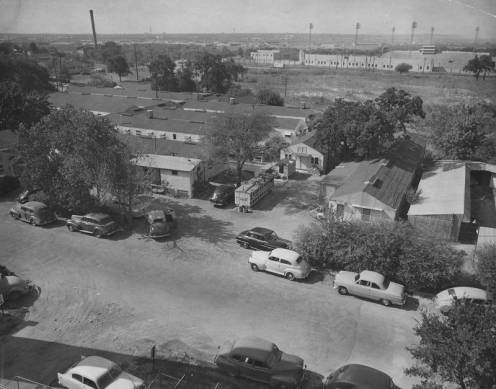
The Hoblitzelles brought excitement to Dallas. The Majestic Theatre hosted film premieres attended by Hollywood stars like Jimmy Stewart, Gregory Peck and John Wayne. (The Hoblitzelle Foundation gifted the Majestic Theatre to the City of Dallas in January 1976.)
When Dr. Cary approached Karl Hoblitzelle with his vision of advancing medical education and scientific research in the Southwest, Hoblitzelle embraced the idea at once.
On January 21, 1939, Dr. Cary — joined by Hoblitzelle, E. R. Brown and Dr. Hall Shannon — obtained a charter for the operation of Southwestern Medical Foundation. The charter was far-sighted, giving the Foundation the flexibility to own and operate a medical school.
At a Foundation dinner held two days later at the Adolphus Hotel, it was agreed that the new medical center should belong to the entire Southwest. Further, that the center should “perpetuate medical education and scientific research in an assured nonsectarian environment.”
Notable charitable foundations such as the Carnegie and Rockefeller Foundations had made it their policy not to contribute to religiously affiliated organizations, and the men estimated that as much as $25 million would need to be raised.
Both Dr. Cary and Karl Hoblitzelle had a tremendous gift for inspiring others and used their influence to call the Dallas philanthropic community to action. Each man wrote eloquently and produced dozens of letters and articles, and spoke with great passion regarding the Foundation’s noble mission and the role that “a great medical center” would play in the care of all Dallas citizens.
While both men contributed financially to the Foundation, the early records of the organization reflect that Hoblitzelle (and later, the Hoblitzelle Foundation) made repeated gifts of $5,000 and $10,000 in order to help keep the Foundation on its feet.
During this period, Dr. Cary commanded the national healthcare stage. In 1939, he helped found the National Physicians Committee, which opposed the idea of a national health insurance. Dr. Cary strongly supported group hospitalization (a precursor to what eventually became health insurance like Blue Cross Blue Shield) as the smarter alternative — believing that federal or state bureaucracy was a means of political control that ultimately would not be in the best interest of the people, the quality of medical care or the medical profession itself. He testified before Congress as one of the country’s leading experts on the subject. It was said at the time that no man fought harder to see that the ethics of the medical profession were maintained.
By June 1940, half a world away, Hitler had taken over France.
In Washington, Congress approved the first peacetime draft in American history.
In Dallas, in August 1940, a telegram was sent to Baylor College of Medicine by U.S. Surgeon General James C. Magee requesting that the college organize a medical unit for the army to be composed of hospital staff, medical school faculty and alumni.
A month later, London was bombed for 57 consecutive nights.
On a Sunday morning, December 7, 1941, the Japanese attacked Pearl Harbor. The next day President Roosevelt called for a declaration of war. Three days later, Japan, Germany and Italy declared war on the United States.
But decades of dreams — dreams that Dr. Cary knew would benefit humanity — weren’t about to be put on hold.
For months he’d been working closely with leading Dallas architects to render a master plan for a medical center on and adjacent to Parkland Hospital.
At the same time, the Foundation had begun to push toward an agreement with Baylor University for the joint operation of Baylor College of Medicine.
On March 8, 1942, Dr. Cary revealed his vision to the public for a sprawling medical center that would be spread across a 35-acre tract of land on Harry Hines Boulevard. The centerpiece of the vision, a new medical school, would be named Southwestern Medical College.
Baylor College of Medicine was offered a detailed proposal to become an integral part of the new center, which was approved by the Board of Trustees at Baylor in Waco on June 23, 1942.
But Dr. Walter H. Moursund, Dean of Baylor College of Medicine in Dallas, had growing concerns. Under the proposed plan, Baylor and the Foundation would share operational roles — Baylor would direct education and academics while the Foundation would handle physical operations — ownership of the buildings constructed by the Foundation would remain with the Foundation. In exchange for financial support and the land to expand, Baylor College of Medicine would be asked to drop its affiliation with Baylor University Hospital and realign with Parkland.
As these issues and others were considered, the agreement was canceled on April 27, 1943. It was immediately announced that the medical school would relocate to Houston, having accepted a proposal offered by the MD Anderson Foundation and other Houston benefactors.
In May, the last Dallas class of Baylor College of Medicine received their diplomas. As the graduation ceremony ended, the challenge to assemble an exemplary medical school landed squarely at Dr. Cary and the Foundation’s feet.
Dr. Davis Spangler, president of the Dallas County Medical Society (DCMS), stepped forward to pledge his organization’s full support of Dr. Cary’s bold vision — an important early endorsement that rallied hundreds of physicians and dentists to the cause.
Still, it would have been an enormous undertaking to pull together in a year, or even two.
To do so in a few short months would take a miracle.